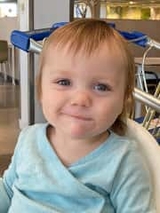Desmoid Tumor: Vaida’s Story
Desmoid Tumor: Vaida’s Story
After Vaida’s family noticed a lump in her left cheek when she was 4 months old, several doctors near their home in Erie, Pa., said some version of “I don’t know what this is,” recalls her mother, Erinn. It took 10 excruciating weeks to get a diagnosis of a desmoid tumor. Eventually the family sought treatment at Children's Hospital of Philadelphia (CHOP) for this rare type of tumor.

Erinn’s father was the first person to notice Vaida’s lump. “It felt like a little marble,” says Erinn. It was March 2020, right at the start of the pandemic. Their pediatrician ordered an ultrasound, but it was inconclusive. The family’s next stop was an ear/nose/throat specialist, who also couldn’t determine what the lump was, and sent them to a pediatric ear/nose/throat specialist. As soon as he felt the lump, “He got a look on his face that said this isn’t what he expected,” says Erinn. He ordered an MRI and then several biopsies which were inconclusive. Vaida underwent surgery, and finally it was determined that the lump was a desmoid tumor.
After the tumor quickly grew back, and the family looked for a second opinion. When Erinn received a touching phone call from Children's Hospital of Philadelphia (CHOP) pediatric oncologist Vandana Batra, MD, it became clear to the worried mom that CHOP was “the right place.”
Benign, but growing quickly
Desmoid tumors are noncancerous growths that occur in the soft connective tissue. There are several reasons why Vaida’s case is challenging: Desmoid tumors are relatively rare, they usually affect adults, and they most often occur in the abdomen, arms and legs. “They weren’t checking for desmoid,” Erinn explains, “because the cheek is such a rare location for it.”
Second Opinions
While desmoid tumors are technically benign, meaning they don’t spread to other areas of the body, they can grow very quickly, acting more like cancers and infiltrating nearby structures and organs. For this reason, patients with desmoid tumors are often cared for by oncologists. Vaida’s tumor had the potential to cause muscle and bone damage, difficulty eating and disfigurement. When Erinn searched online for case studies of facial desmoid tumors, “They were the worst stories ever — it was terrifying.”
Vaida had her first surgery in Pittsburgh to remove the tumor and started oral chemotherapy, but the tumor grew back in just six weeks. Unsure of what to do, the family searched for a second opinion. When Erinn contacted CHOP, she spoke with the nurse navigator in the Division of Plastic, Reconstructive and Oral Surgery. “I said I want someone who has seen this before or is not afraid to ask someone who has,” says Erinn. They quickly got appointments with pediatric plastic surgeon Scott Bartlett, MD, who directs the Craniofacial Program, and with Dr. Batra.
Very early on the day of the appointment, Erinn, her sister and Vaida were driving across Pennsylvania. The Philadelphia area was under a hurricane threat and tornado warnings. “My cell phone rang,” Erinn recalls. “It was Dr. Batra herself. I hadn’t yet met her. She said, ‘I know you’re traveling in. I want you to be safe. So if you need to pull over, I will wait for you.’” Erinn deeply appreciated the thoughtfulness and the direct communication from Dr. Batra. “I looked at my sister and said, ‘We are going to the right place.’”
Retaining impressive function after surgery

At CHOP, in order to try to shrink the tumor prior to surgery, Vaida underwent cryotherapy, a procedure performed by interventional radiologist Michael R. Acord, MD, in which gas is pumped through a thin needle into the tumor to freeze the tissue. Then Dr. Bartlett performed surgery to remove as much of the tumor as possible — a particular challenge with desmoid tumors, which send little threads into the surrounding tissue. “When he went in, he saw how extensive it was,” says Erinn. “He got as much as he could that would still allow her as much function as possible afterward.”
Everyone has been impressed with how much muscle function Vaida has maintained even though the surgery removed muscles damaged by the tumor. She can still drink from a straw, and she hasn’t needed speech therapy. “She has function that we didn’t think she’d have,” says Erinn.
Vaida, now 2, is on a yearlong course of chemotherapy. “She is the toughest little girl,” Erinn says with awe. “And she is fun and energetic and smart.” What’s ahead for this tough cookie? “Finding the right course of medication that she can take long-term that will keep the tumor from growing.”